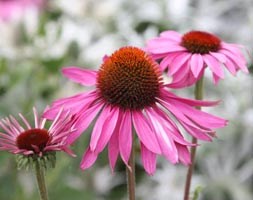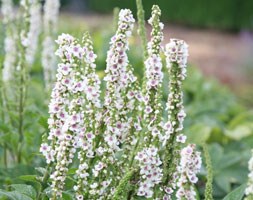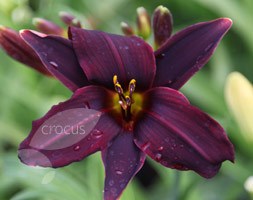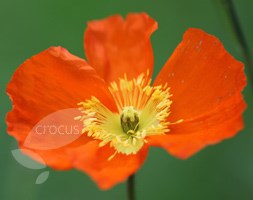New products at Crocus
by Sarah - June 7th, 2013.Filed under: Crocus, New Products.
Crocus has these new items today
Echinacea purpurea ‘Rubinglow’ (coneflower) £9.99
Position: full sun Soil: most soils, except very dry or boggy Rate of growth: average Flowering period: June to September Hardiness: fully hardy Pinky-red ray florets form a horizontal ruff around a prominent orange-brown cone of disc florets on these decorative flowerheads. Appearing for a long period from midsummer to mid autumn, they associate well with grasses. Garden care: Lift and divide congested colonies in autumn or spring. In autumn cut back all dead flower stems to the ground. Coneflower s benefit from a spring or autumn mulch with well-rotted compost.
Verbascum chaixii ‘Album’ (mullein) £8.99
Position: full sun Soil: poor, well-drained, alkaline soil Rate of growth: average Flowering period: May to August Hardiness: fully hardy (but short-lived) Bold spires of saucer-shaped, white flowers with mauve centres from May to August. One of the most reliable and long-flowering varieties of verbascum. Seeds sown in a cold frame in late spring or early summer produce rosettes of hairy, mid-green leaves and flowers the following year. Perfect for a sunny border. Garden care:Apply a 5-7cm (2-3in) mulch around the base of the plant in autumn to protect from winter extremes, taking care not to cover the crown. Stake in spring with bamboo canes or twiggy prunings before the flowers appear. Mullein moth caterpillars can be a problem, pick off the insects in early June as soon as they appear. Remove faded flower spikes. It is worth keeping in mind that these plants are mainly biennial, so although they usually self-seed freely, the plant will only live for two years.
Hemerocallis ‘American Revolution’ (daylily) £8.99
Position: full sun Soil: fertile, moist, well-drained soil Rate of growth: average Flowering period: June to July Hardiness: fully hardy This is a large, deep blood-red daylily that flowers from June to July. It look s fabulous planted in drifts in a sunny mixed or herbaceous border among ‘hot’ colours or with cannas and montbretias as companions. The bright-green, strap- like leaves are semi-evergreen in mild areas, and soon form large clumps of stra p-like foliage that helps to suppress weeds. Like most hemerocallis, it is robu st and easy to grow, provided you follow the tips below. Garden care: The Greek term ‘hemerocallis’ means ‘beautiful for a day’, and daylilies need regular deadheading to prolong flowering and prevent their unsightly deadheads from dominating the scene. Each stem carries several flowers, so snap off each flower as it fades. When the stem has finished flow ering, cut it down to the ground. After the plant has finished flowering altoge ther, pull out the dead leaves. When the foliage is looking tatty, cut it down to the ground and fresh new growth will appear. Lift and divide every two years in spring to keep the rhizomes vigorous and apply a generous 5-7cm (2-3in) mulch of well-rotted garden compost or manure around the base of the plant. Water frequently from spring until the buds appear.
Papaver nudicaule ‘Champagne Bubbles F1 Orange’ (Iceland poppy) £7.99
Position: full sun Soil: moist, well-drained Rate of growth: average Flowering period: June to August Flower colour: orange Other features: the flowers look wonderful in a vase Hardiness: hardy biennial (or annual) Icelandic poppies are perfect for a sunny border or cottage garden where they will produce an abundance of colourful blooms throughout the summer. The orange flowers are held on sturdy stems above the foliage. They look dazzling in a vase and should be gathered in bud the evening before they’re needed. Garden care: Sow shallowly, directly into a well prepared bed in spring and water well. As the seedlings develop, thin them out to 30cm intervals keeping just the healthiest and most robust plants. Protect the emerging seedlings from slugs and snails. Deadheading will help prolong the flowering period. Sow: March-May Flowering: June-August Approximate quantity: 1200 seeds










